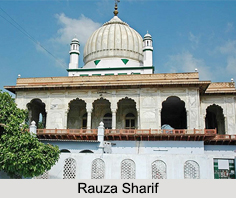 Rauza Sharif is a dargah of Sheikh Ahmed Farooqi Sirhindi which is situated on the Sirhind in Punjab. It is situated at a small distance to the north of Gurdwara Fatehgarh Sahib. Sheikh Ahmed Farooqi lived at this place during the times of Akbar and Jahangir from 1563 to 1624. He is more popularly known as "Mujaddid, Alf Sani".
Rauza Sharif is a dargah of Sheikh Ahmed Farooqi Sirhindi which is situated on the Sirhind in Punjab. It is situated at a small distance to the north of Gurdwara Fatehgarh Sahib. Sheikh Ahmed Farooqi lived at this place during the times of Akbar and Jahangir from 1563 to 1624. He is more popularly known as "Mujaddid, Alf Sani".
Rauza Sharif is regarded as the second Mecca for Sunni Muslims. It has been constructed at Sirhind to commemorate the valiant youngsters who gave up their lives when tempted to give up their religion for Islam. There are a number of other tombs in the compound mostly of the members of Sheikh Ahmed"s house. There is a grand mosque with a basement and a small tank for performing ablution before the prayers. The shrine has since been taken over by Government of India as a historic monument.
Celebration at Rauza Sharif
The Urs celebration (death anniversary) of Sheikh Ahmed Farooqi is held here for more than 300 years and are largely attended by Muslims from India, Pakistan, Afghanistan, Indonesia, Bangladesh and other Muslim countries.
This article is a stub. You can enrich by adding more information to it. Send your Write Up to content@indianetzone.com.





















